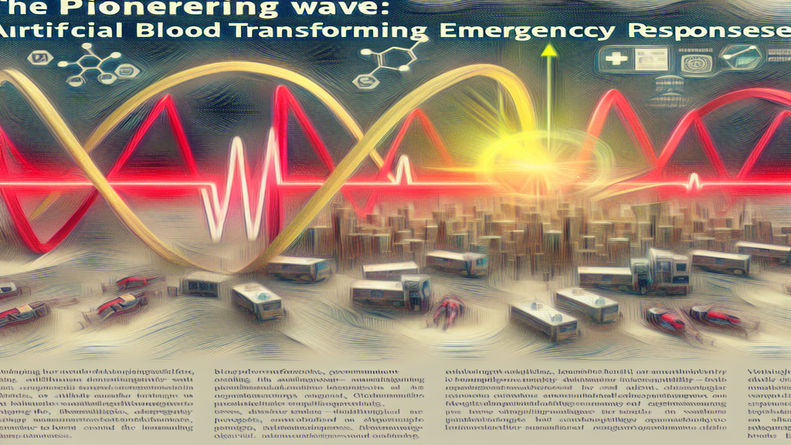Imagine living in a world where artificial blood is much more than a mere medical marvel; it is a consistent lifesaver poised to revolutionize emergency responses in disaster zones. The world is already witnessing such a change, with cutting-edge artificial blood solutions controlling the realms of medical crises, and offering innovative solutions to complex problems. So, the question here is, can artificial blood serve as a persistent and robust resource for medical emergencies? Can medical professionals integrate this technology seamlessly to generate life-saving results in disaster-stricken areas? This blog post sheds light on these questions and offers an inspiring roadmap for humanitarian efforts and medical advancements.
🌪️ The Initial Struggles: Navigating the Challenges of Emergency Response
Starting a conversation on artificial blood, one must first appreciate the difficulties and challenges in current emergency responses, particularly in disaster zones. These are environments where time is of the essence, resources are scarce, and storage conditions are far from ideal. The tough start for artificial blood begins here, in these hostile environments, where the uncertainties of product transportability, temperature sensitivity, and disease contamination test the innovation’s potential. Early-stage artificial blood prototypes faced these harsh realities however, each roadblock brought valuable learning experiences that would eventually shape the technology into a reliable emergency response tool.
🔬 The Turning Point: A Technological Breakthrough
Then comes the exhilarating moment of scientific triumph — the development of synthetic blood that doesn’t necessitate refrigeration and stands impervious to disease. This breakthrough serves as a critical turning point, signaling the metamorphosis from laboratory curiosity to a tangible asset in saving lives. The impact of this advancement cannot be overstated; it provides a revolutionary solution for medical professionals working in austere settings. From earthquake relief to battlefield care, synthetic blood’s shelf-stable and disease-free qualities can make rapid transfusions a reality, enabling a new chapter in emergency medical care.
⚙️ Scaling Up: The Expansion of Artificial Blood Deployment
 After the pivotal breakthrough, focus shifts to scaling up artificial blood’s presence in emergency medical care. This expansion can take several forms: increasing production capacities, streamlining distribution networks, and raising awareness among medical agencies and organizations. As the technology gains traction, the challenge becomes ensuring consistent quality and effectiveness across diverse environments. Strategies must therefore not only aim for increased dissemination of synthetic blood but also for meticulous oversight to maintain its lifesaving properties when it matters most.
After the pivotal breakthrough, focus shifts to scaling up artificial blood’s presence in emergency medical care. This expansion can take several forms: increasing production capacities, streamlining distribution networks, and raising awareness among medical agencies and organizations. As the technology gains traction, the challenge becomes ensuring consistent quality and effectiveness across diverse environments. Strategies must therefore not only aim for increased dissemination of synthetic blood but also for meticulous oversight to maintain its lifesaving properties when it matters most.
📚 Lessons Learned: Key Takeaways from Synthetic Blood Advancements
With a global scale-up, lessons emerge. First, collaboration underscores advancement; partnerships between biotech firms, governments, and humanitarian organizations are critical. A customer-centric approach proves vital, addressing specific medical needs in crisis scenarios. Persistent effort in research and development leads to consistent improvement in synthetic blood products, but awareness of potential pitfalls, such as regulatory challenges and acceptance in the medical community, remains essential. Each takeaway offers a stepping stone to even greater successes in artificial blood utilization.
🔮 The Future: Visions of Artificial Blood in Global Health
Peering into the future, the horizon for artificial blood shines bright. Innovators and healthcare providers envisage a world where synthetic blood is an integral part of emergency kits, ready for rapid deployment anywhere. Upcoming strategies hinge on perfecting the product and ensuring its integration into standard medical protocols. As aspirations grow, so does the confidence in achieving even bolder milestones — an emergency response system revolutionized by the reliability and accessibility of artificial blood.
🔄 Conclusion: Cementing the Role of Artificial Blood in Disaster Response
In sum, the journey of artificial blood from conception to a vital cog in the emergency response mechanism is a narrative of resilience, innovation, and foresight. It underlines the transformative power of medical technology and its direct impact on human lives, especially when tested by natural and man-made calamities. With continued dedication to progress and a commitment to excellence, artificial blood stands poised to redefine emergency medicine, turning what was once a scientific aspiration into a global reality.Are you ready to join the movement and redefine the scope of what’s possible within healthcare and emergency responses? Connect with me on [LinkedIn] to explore how you can be part of this life-saving revolution. 🚀🌟
